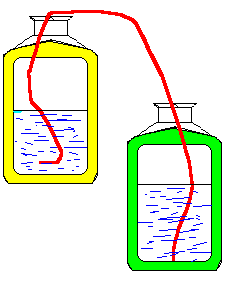
The Simple Siphon

I must admit that the simplicity of the siphon has always fascinated me. Basically it involves using two jars. The yellow jar contains water and the end of a hose is placed in this below the surface. The hose can be filled either by suction or by filling from a tap. Once the hose is full of water and the other end is held lower than the surface of the water in the yellow jar, water will flow through the hose until the level of water is the same in both jars.
A possible explanation for the way the system works is that the siphon uses pressure. The pressure at the end of the hose in the green jar is equal to atmospheric pressure which is the same as the pressure in the yellow jar. However the end in the green jar also has the added pressure of the water in the length of hose which is below the surface of the yellow jar. This causes the water to fall.
|
|
Place two jars on a level surface as shown in the diagram. If the hose between the jars is full of water, the water level in both jars will be the same. (If the levels were different, the water would siphon from one jar to the other until the water in both jars reached the same level.) When the water in both jars has reahed the same level, place a mark on the outside of the jars at the surface. |
|
|
|
Now place the jars further apart on a not so level surface. These are more common in buildings than you would think. Make sure you keep the ends of the hose beneath the surface. If the ground is not level, water will siphon fom the jar on the higher ground to that on the lower ground. This can be easily checked and measured by comparing the level of the water in the jars to the marks made in the previous section. |